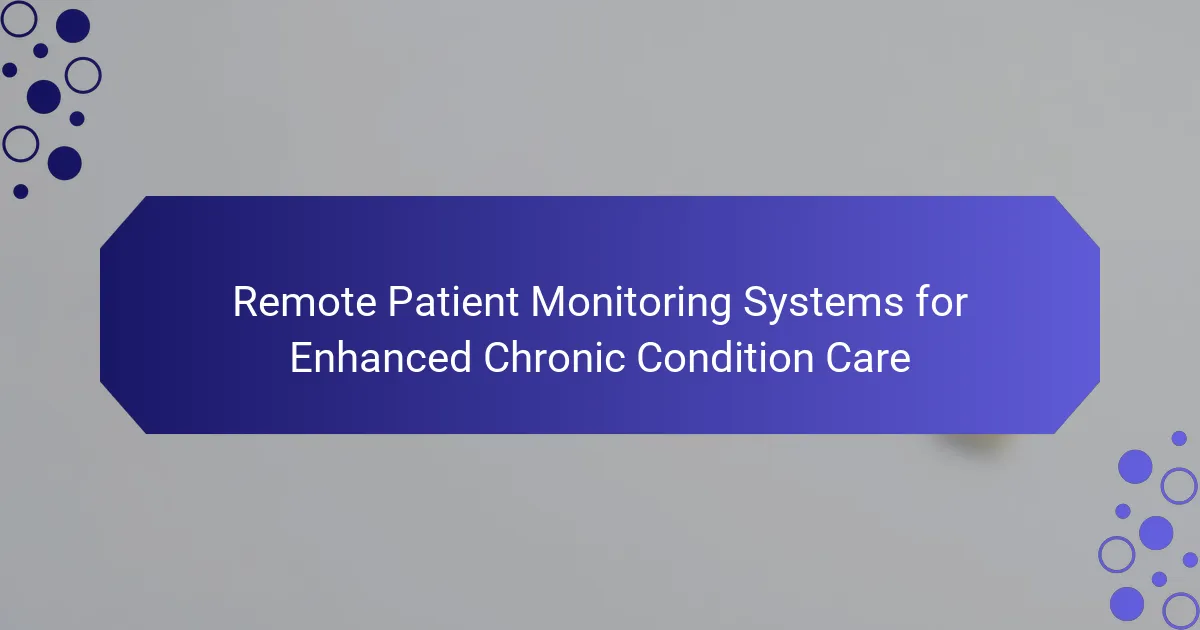Remote Patient Monitoring Systems enhance chronic condition care by providing continuous health monitoring and improving patient engagement. These systems facilitate real-time data collection and analysis, enabling timely interventions. They also address challenges such as data security and patient demographics, ensuring effective implementation. Emerging trends like AI integration and telehealth further improve care coordination and patient outcomes.
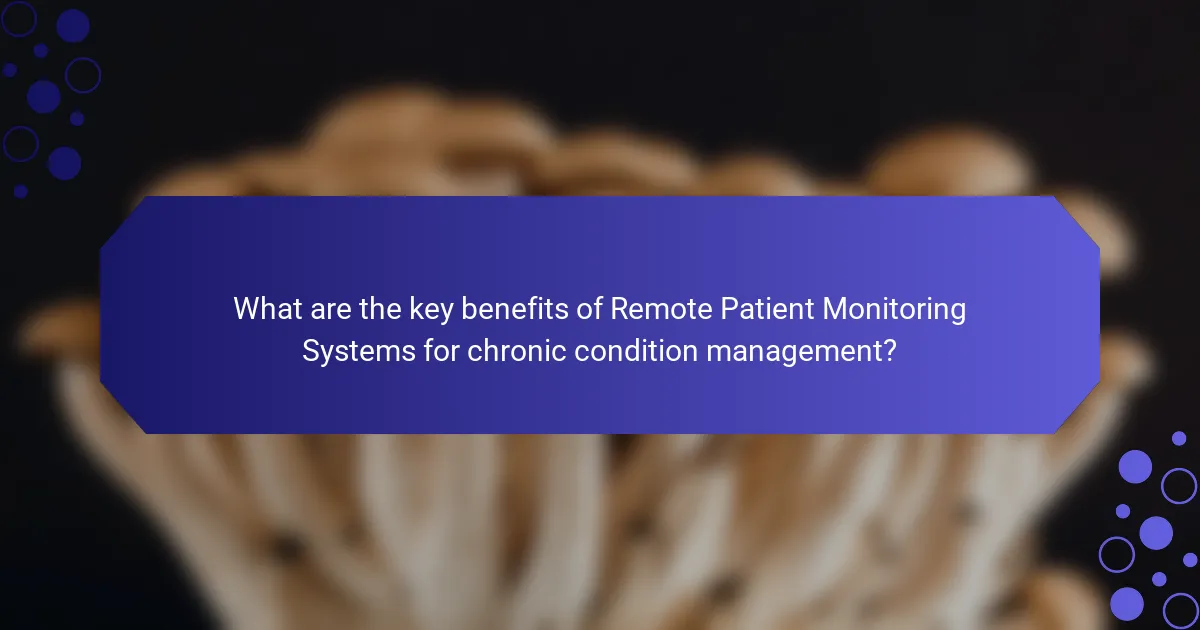
What are the key benefits of Remote Patient Monitoring Systems for chronic condition management?
Remote Patient Monitoring Systems significantly enhance chronic condition management by providing timely data and improving patient engagement. Key benefits include continuous health monitoring, which leads to early detection of issues, personalized care plans, and reduced hospital admissions. These systems also facilitate better communication between patients and healthcare providers, fostering a proactive approach to health management. As a result, patients experience improved health outcomes and increased satisfaction with their care.
How do these systems improve patient engagement and adherence to treatment?
Remote patient monitoring systems significantly enhance patient engagement and adherence to treatment. These systems provide real-time health data, enabling proactive management of chronic conditions.
Patients receive timely feedback on their health metrics, fostering a sense of accountability. This immediate access to information helps individuals understand their conditions better, motivating them to adhere to treatment plans.
Moreover, remote monitoring facilitates regular communication with healthcare providers. This ongoing dialogue helps address concerns promptly, reinforcing adherence and improving overall health outcomes.
Incorporating features like medication reminders and educational resources further empowers patients. These tools not only enhance engagement but also support informed decision-making regarding their health.
What impact do Remote Patient Monitoring Systems have on healthcare costs?
Remote Patient Monitoring Systems significantly reduce healthcare costs by minimizing hospital admissions and enabling proactive care. These systems enhance chronic condition management through continuous data collection and analysis, leading to timely interventions. Studies indicate a potential cost reduction of 20-30% in chronic disease management through effective remote monitoring, as it decreases the need for emergency care. Additionally, they empower patients, promoting better adherence to treatment plans and ultimately lowering overall healthcare expenditures.
Which chronic conditions benefit most from Remote Patient Monitoring?
Chronic conditions that benefit most from Remote Patient Monitoring include diabetes, hypertension, heart disease, asthma, and chronic obstructive pulmonary disease (COPD). These conditions see improved management through continuous data collection and real-time feedback. For instance, diabetes patients can track blood glucose levels, while heart disease patients can monitor vital signs. Remote Patient Monitoring enhances patient engagement and adherence, leading to better health outcomes. Studies indicate a 30% reduction in hospital readmissions for patients using these systems, showcasing their effectiveness in chronic care management.
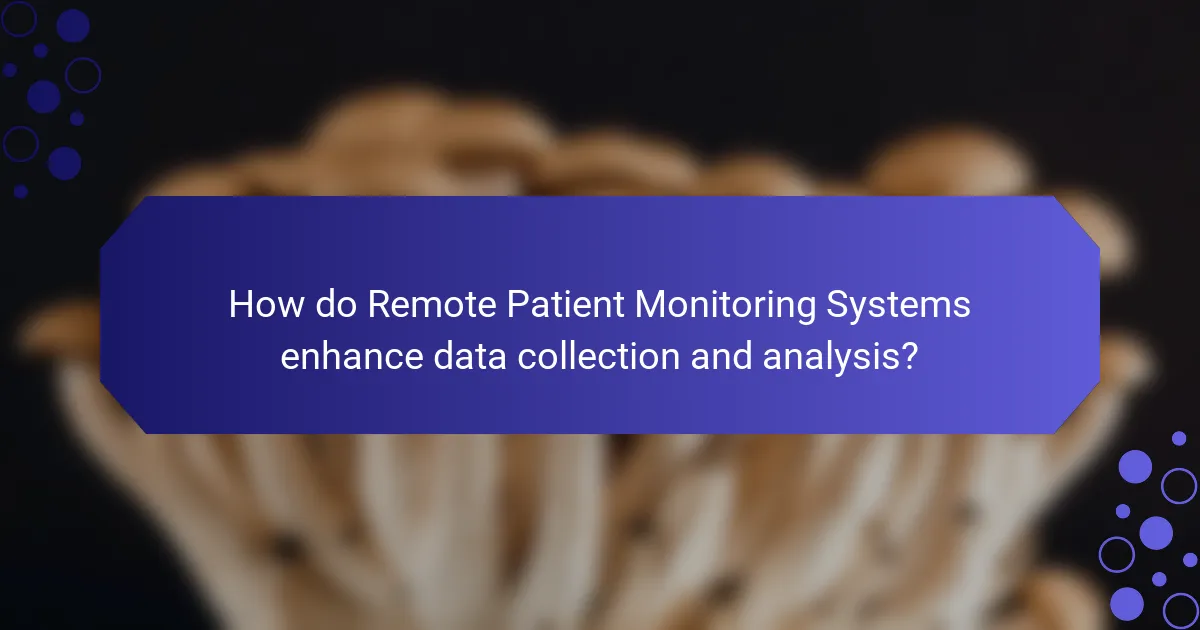
How do Remote Patient Monitoring Systems enhance data collection and analysis?
Remote Patient Monitoring Systems significantly enhance data collection and analysis through real-time patient data transmission. These systems provide continuous monitoring, enabling healthcare providers to track patient health metrics efficiently.
The integration of wearable devices allows for comprehensive data gathering, including vital signs and activity levels. As a result, clinicians can make informed decisions based on accurate, up-to-date information.
Additionally, data analytics tools within these systems identify trends and patterns in patient health, leading to proactive care interventions. This capability is crucial for managing chronic conditions effectively, reducing hospital visits, and improving patient outcomes.
Overall, Remote Patient Monitoring Systems optimize the management of chronic conditions by facilitating timely data collection and insightful analysis.
What types of health data can be monitored remotely?
Remote patient monitoring systems can track various health data, including vital signs, glucose levels, heart rate, blood pressure, and medication adherence. These systems enhance chronic condition care by providing real-time insights. For example, continuous glucose monitoring devices send data directly to healthcare providers, enabling timely interventions. Additionally, remote monitoring can improve patient engagement and adherence to treatment plans, leading to better health outcomes.
How is data security maintained in Remote Patient Monitoring Systems?
Data security in Remote Patient Monitoring Systems is maintained through encryption, access controls, and regular security audits. These measures protect sensitive patient data from unauthorized access and breaches. Encryption ensures data is unreadable during transmission, while access controls limit who can view or modify information. Regular audits help identify vulnerabilities and enhance overall security protocols, ensuring compliance with regulations like HIPAA.
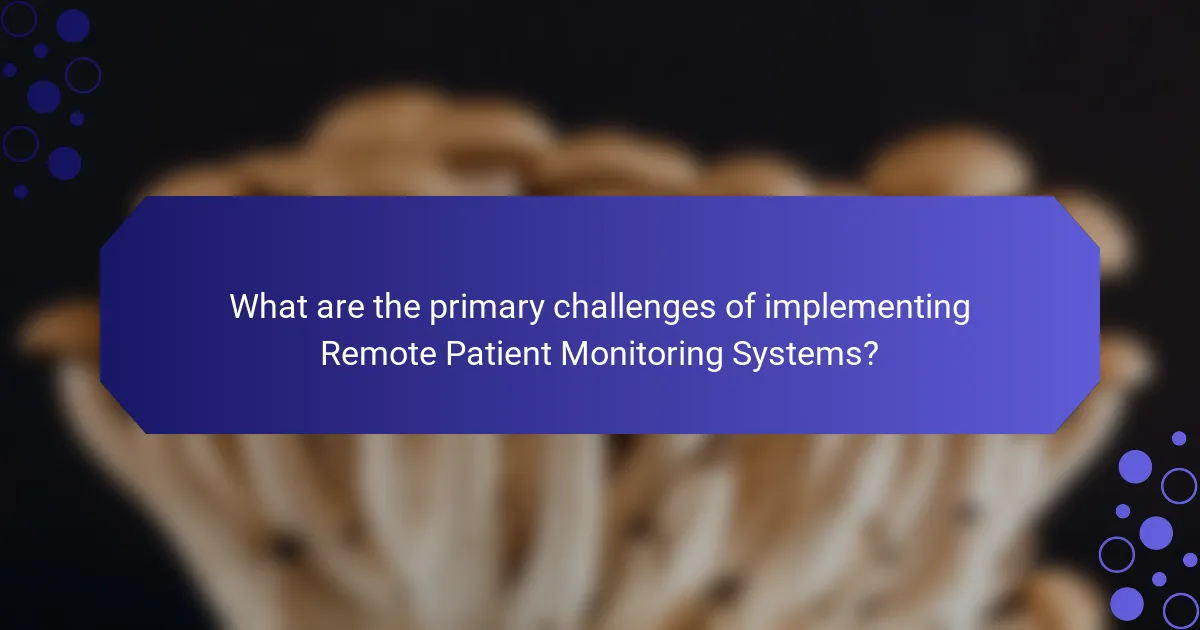
What are the primary challenges of implementing Remote Patient Monitoring Systems?
Implementing Remote Patient Monitoring Systems faces several challenges, including data security, integration with existing healthcare systems, and patient engagement. Data security concerns arise due to sensitive health information being transmitted. Integration issues can hinder seamless communication between devices and electronic health records. Patient engagement is critical; without proper training, patients may struggle to use the technology effectively. Addressing these challenges is essential for successful implementation and improved chronic condition care.
How do healthcare providers address patient privacy concerns?
Healthcare providers address patient privacy concerns by implementing robust data protection measures in remote patient monitoring systems. These measures include encryption, secure access controls, and compliance with regulations like HIPAA. Such systems enhance chronic condition care while ensuring that sensitive patient information remains confidential. Regular audits and patient education further strengthen trust and security.
What technological barriers exist for patients using these systems?
Technological barriers for patients using remote patient monitoring systems include connectivity issues, device compatibility, data security concerns, user interface complexity, and lack of technical support. These factors hinder effective utilization and patient engagement. Connectivity issues may arise from poor internet access, making it difficult for patients to transmit data. Device compatibility can limit the integration of various monitoring tools. Data security concerns may deter patients from sharing sensitive health information. Complex user interfaces can lead to confusion, particularly among older adults. Finally, inadequate technical support can exacerbate these challenges, leaving patients feeling unsupported.
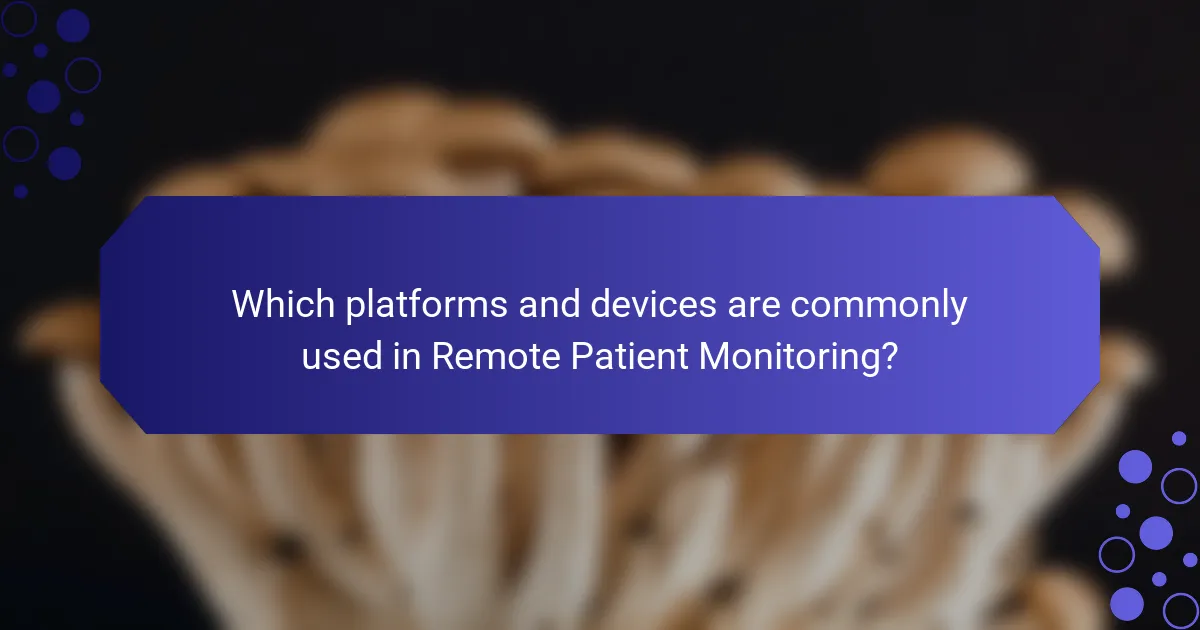
Which platforms and devices are commonly used in Remote Patient Monitoring?
Remote patient monitoring systems commonly utilize smartphones, tablets, wearable devices, and specialized medical equipment. These platforms facilitate real-time health tracking and data sharing, enhancing chronic condition management. Wearable devices, such as smartwatches, often include sensors for heart rate and activity levels. Smartphones and tablets serve as user interfaces for patients and healthcare providers, enabling remote consultations. Specialized medical equipment, like blood glucose monitors, integrates with mobile apps for comprehensive health monitoring. This multi-device approach ensures continuous patient engagement and timely medical interventions.
How do wearable devices integrate with Remote Patient Monitoring systems?
Wearable devices enhance Remote Patient Monitoring systems by providing real-time health data, improving chronic condition management. These devices track vital signs, activity levels, and medication adherence, ensuring timely interventions. Integration allows seamless data transmission to healthcare providers, fostering proactive care. Enhanced analytics from wearables can identify trends, leading to personalized treatment plans. This synergy ultimately improves patient outcomes and reduces hospital visits.
What software solutions are popular among healthcare providers for Remote Patient Monitoring?
Popular software solutions for Remote Patient Monitoring include platforms like Philips HealthSuite, Medtronic Care Management Services, and MyTelemedicine. These systems enhance chronic condition care by providing real-time data tracking, patient engagement tools, and analytics for healthcare providers. Additionally, software like BioTelemetry and WellSky offers unique features such as remote ECG monitoring and integrated care coordination. These solutions typically support various devices, ensuring comprehensive patient management.
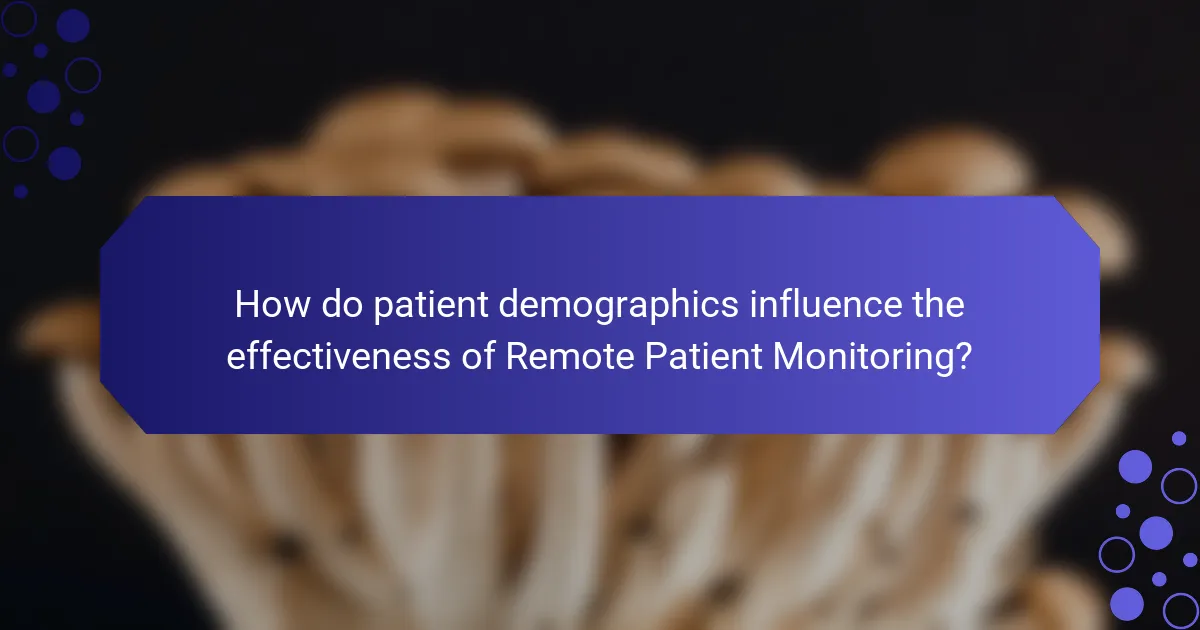
How do patient demographics influence the effectiveness of Remote Patient Monitoring?
Patient demographics significantly influence the effectiveness of Remote Patient Monitoring (RPM) by impacting engagement and adherence. Age, socioeconomic status, and health literacy shape how patients interact with RPM systems.
Younger patients often adapt quickly to technology, leading to higher engagement rates. In contrast, older adults may face challenges with device usage, affecting their ability to manage chronic conditions effectively. Socioeconomic factors can limit access to technology, creating disparities in RPM effectiveness.
Health literacy is crucial; patients with a better understanding of their health are more likely to utilize RPM tools effectively. Tailoring RPM systems to address these demographic factors can enhance patient outcomes in chronic condition management.
What role does age play in the adoption of Remote Patient Monitoring technologies?
Age significantly influences the adoption of Remote Patient Monitoring technologies. Older adults often face barriers such as technology familiarity and perceived complexity. Younger populations, however, typically exhibit higher comfort levels with digital tools, facilitating quicker adoption. Studies show that individuals aged 65 and older are less likely to engage with these systems compared to those aged 18-34. Additionally, age-related health conditions necessitate monitoring, yet older patients may require more support to utilize these technologies effectively. Tailored approaches can enhance acceptance among older demographics, ensuring better management of chronic conditions.
How do cultural factors affect patient acceptance of Remote Patient Monitoring?
Cultural factors significantly influence patient acceptance of Remote Patient Monitoring (RPM). Attitudes towards technology, healthcare practices, and trust in medical systems vary across cultures, affecting how patients perceive RPM.
For instance, cultures that prioritize personal relationships in healthcare may prefer face-to-face consultations over remote solutions. Additionally, beliefs about health and wellness can shape the willingness to adopt RPM technologies.
Education levels and access to technology also play a role; communities with higher digital literacy are more likely to embrace RPM. Furthermore, language barriers can hinder effective communication, impacting patient engagement with RPM systems.
Overall, understanding these cultural nuances is essential for healthcare providers to enhance RPM adoption and improve chronic condition care.
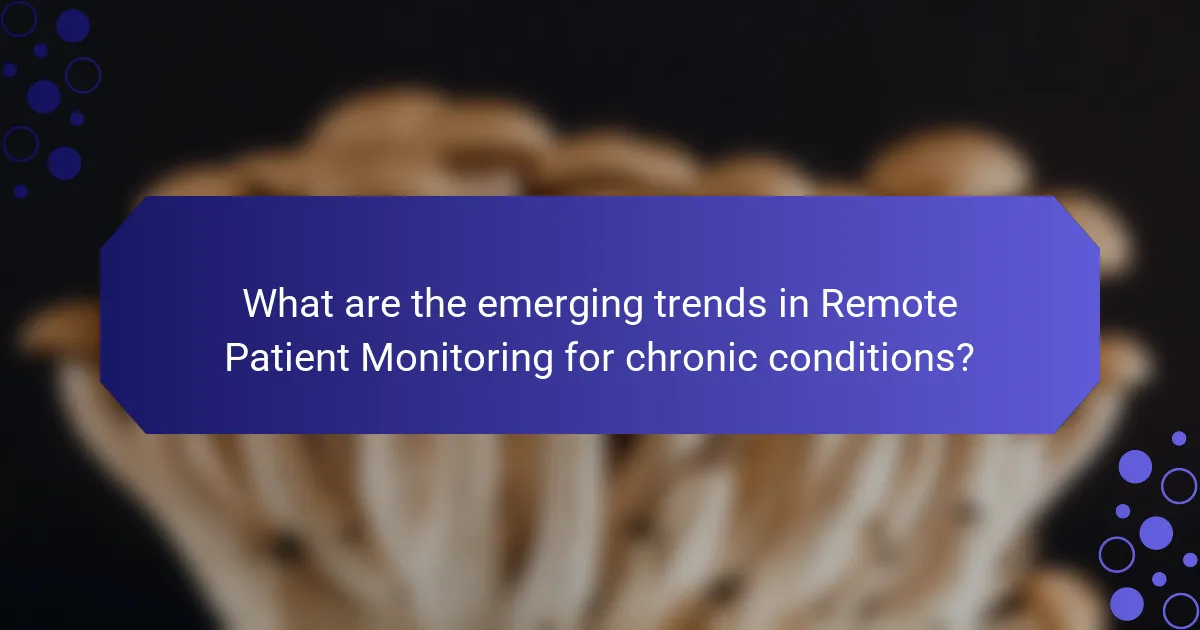
What are the emerging trends in Remote Patient Monitoring for chronic conditions?
Emerging trends in remote patient monitoring systems enhance chronic condition care through advanced technology integration. These systems leverage artificial intelligence for predictive analytics, improving patient outcomes. Wearable devices monitor vital signs in real-time, allowing for timely interventions. Telehealth integration facilitates seamless communication between patients and providers, enhancing care coordination. Data security measures are evolving to protect patient information, addressing privacy concerns. Increased patient engagement through mobile applications fosters adherence to treatment plans, leading to better management of chronic conditions.
How is artificial intelligence shaping the future of Remote Patient Monitoring?
Artificial intelligence is revolutionizing remote patient monitoring by enhancing data analysis and patient engagement. AI algorithms process vast amounts of health data, providing real-time insights that help healthcare providers make informed decisions. This leads to improved chronic condition management and personalized care plans. Additionally, AI-driven predictive analytics can identify potential health risks before they escalate, allowing for timely interventions. Overall, AI’s integration into remote patient monitoring systems significantly enhances patient outcomes and reduces healthcare costs.
What innovations are on the horizon for Remote Patient Monitoring Systems?
Innovations in Remote Patient Monitoring Systems include advanced AI analytics, real-time data integration, and enhanced user interfaces. These developments aim to improve chronic condition management by providing personalized insights and predictive alerts. For instance, AI can analyze patient data to forecast potential health issues, allowing for timely interventions. Additionally, integration with wearable devices enhances data accuracy and patient engagement, ultimately leading to better health outcomes.
What are the best practices for optimizing Remote Patient Monitoring Systems?
To optimize Remote Patient Monitoring Systems, focus on data accuracy, user-friendly interfaces, and seamless integration with existing healthcare systems. Prioritize patient engagement through personalized feedback and timely alerts. Ensure compliance with privacy regulations to build trust. Regularly update technology to enhance functionality and security.
